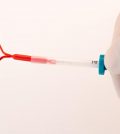- Listeria Danger Spurs Nationwide Recall of Frozen Waffles
- Washington Becomes 6th State to Report Bird Flu in Humans
- Seniors Who Split: Rates of ‘Gray Divorce’ Have Tripled Since 1990
- Black Patients 22% More Likely to Die After Bypass Surgeries
- Cataract Surgery Could Save Your Eyesight and Maybe Your Life
- Could Caffeine in Pregnancy Help Prevent Cerebral Palsy in Kids?
- Fatal Opioid-Meth Overdoses Have Fallen in U.S. by More Than a Third
- At-Home Brain Stimulation Treatment Can Safely Ease Depression
- Even Hardcore Smokers May Quit If Given Right Tools, Study Finds
- Light Therapy Might Help Ease ‘Dry’ Form of Macular Degeneration
Health Highlights: Dec. 30, 2013


Here are some of the latest health and medical news developments, compiled by the editors of HealthDay:
Health Law Calls for Calorie Counts on Vending Machines
There may be a lot more counting of calories when people buy snacks from vending machines or order food in certain restaurants under rules currently being crafted as part of the final phase of the Affordable Care Act.
Once the regulations are in place, calorie information will have to be displayed on roughly 5 million vending machines in many companies and in restaurants with more than 20 locations. The hope is that the changes will help consumers make healthier choices, the Associated Press reported.
It won’t be a cheap change, with the U.S. Food and Drug Administration estimating it will cost almost $26 million the first year and $24 million a year after that, the AP reported. And companies with vending machines will have to foot the bill. Businesses will be given a year to comply with the new rules, although the vending machine industry has already asked for a two-year deadline, according to the wire service.
The rules will apply to about 10,800 companies that operate 20 or more vending machines. Nearly three quarters of those companies have three or fewer employees, and their profit margin is extremely low, an industry group told the AP.
“The money that would be spent to comply with this — there’s no return on the investment,” Eric Dell, vice president for government affairs at the National Automatic Merchandising Association, told the wire service.
Restaurant chains with more than 20 locations will also have to post calorie information, under another set of rules the FDA is finalizing. Certain cities already require this, and some large fast-food operations do it voluntarily, according to the AP.
Only one in six customers look at calorie counts, but those who do tend to order about 100 fewer calories, according to a 2011 study that was done in New York City. A more recent study in Philadelphia found no difference in food buying patterns after the city’s labeling law took effect, the wire service reported.
The vending machine industry group does have a program that places stickers in front of products that meet healthy guidelines for fat and sugar content. That program is used by nearly 14,000 businesses, schools and government agencies, along with the military, the AP reported.
—–
Neanderthals May Have Passed on Diabetes Risk Gene
Thanks to interbreeding between modern humans and Neanderthals some 60,000 years ago, a gene variation that raises the risk for diabetes appears in up to 20 percent of people in Mexico and Latin America, a new study suggests.
This higher-risk version of the gene — known as SLC16A11 — makes diabetes 25 percent more likely in people who carry the gene, and 50 percent more likely in those who inherited copies from both parents, according to the study published Dec. 25 in Nature.
Researchers Jose Florez and colleagues analyzed samples from more than 8,000 people. Further analysis showed the gene variation matched that in a newly sequenced Neanderthal genome from Denisova Cave in Siberia, according to BBC News.
“To date, genetic studies have largely used samples from people of European or Asian ancestry, which makes it possible to miss culprit genes that are altered at different frequencies in other populations,” Florez, an associate professor of medicine at Harvard Medical School, told BBC.
Up to half of people with recent Native American ancestry have been found to carry the higher-risk gene type, according to the BBC.
“By expanding our search to include samples from Mexico and Latin America, we’ve found one of the strongest genetic risk factors discovered to date, which could illuminate new pathways to target with drugs and a deeper understanding of the disease,” Florez said.
Copyright © 2024 HealthDay. All rights reserved.










